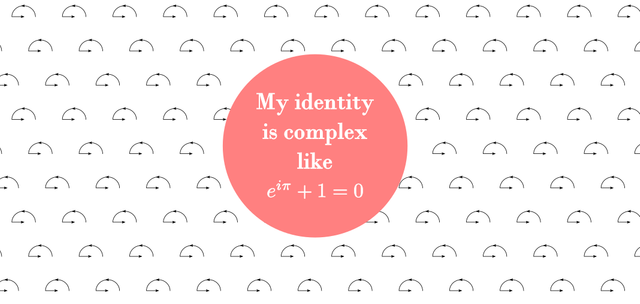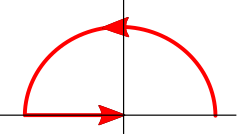My identity is complex
In this post I will explain why the equation in the top figure is special. If you are afraid of long equations then this post is safe since I will explain everything using pictures :)

During a calculus course (or maybe just by browsing the internet) you might have come across the following aesthetically pleasing equality:

It is called the Euler identity and it is beautiful. Why is it beautiful? If you look at the equation then you can see that there is a 0,1, e , π and i (if you are not familiar with i you can just think about it as a special number). These five numbers are the building blocks of a large chunk of mathematics. So (at least part of) the beauty of the Euler identity is derived from connecting these numbers in a special way. If you are interested in an easy to understand proof of the above equality then you can have a look at this Khan academy video
More than just an equation.
It is very tempting to only think about the Euler identity as an equation. However, you can appreciate it even better if you think about it in geometrical way, by which I mean, thinking about it in terms of a picture. The Euler identity represents the following:

So it corresponds to first moving along half a circle in a plane and then moving in a straight line to zero (this is a direct consequence of the Euler formula ). Well you might say this is nothing special, but this is not any plane. This is the complex plane!
An informal introduction to the complex plane
To avoid defining the complex plane (or complex numbers) I will just talk about it as informal as possible. So similar as with a normal plane you have a horizontal and a vertical axis. On the horizontal axis I will just put the numbers that you know, these are called real numbers, and on the vertical axis I will put the special numbers, called imaginary numbers:

So every point in this plane is made out of a real number and an imaginary number.
What is so special about the complex plane? Just as an example let's consider the following red part of the complex plane:

If I multiply this by a imaginary number corresponding to the upper part of the vertical axis then I end up in this part of the plane:

We can also have a look at where the edges along the axes go under multiplication by a imaginary number corresponding to the upper part of the vertical axis:

What this shows is that there is some kind of hidden symmetry in the complex plane. So this is vastly different from a normal plane. When you apply a more complicated operation to part of the complex domain you can end up with extremely difficult images.
Back to the Euler identity
As you might have suspected the i in this equation is an imaginary number. How do we interpret this equation with our understanding of the complex plane?
Informal answer. The symmetry of the complex plane makes it difficult to perform operations which would have been simple in the ordinary plane. The Euler identity in a sense exemplifies this since it does something very simple geometrically while the equations are quite complicated.
If it is so difficult to work in the complex plane then why do we even bother studying it? Well, the symmetry gives rise to some pretty cool stuff like this fractal:

The symmetry of the complex plane also shows up in many real life applications such as image/video compressing but also noise filtering [1]. The symmetry of the complex plane makes the math more difficult but at the same time it creates more applications which is great for mathematicians and non-mathematicians :)
Sources and further reading
This is post is pretty much based on my own understanding of complex analysis. A nice study book on the topic is
[1] Fundamentals of Complex Analysis with Applications to Engineering, Science, And Mathematics by Edward B. Saff Arthur David Snider
The fractal was made using a sloppy mathematica code I wrote. The rest of the pictures/figures made with Inkscape. Equations rendered using quicklatex
Merchandise :D
.png)
There is a MathOwl shop which sells my artsy fartsy stuff. If you got some spare money head over there. You can get complex t-shirts over here. I also have really cheap stuff available like these stickers They are an absolute hoot.
Join #steemSTEM
#steemSTEM is a community project with the goal to promote and support Science, Technology, Engineering and Mathematics related content and activities on the STEEM blockchain. If you wish to support the #steemSTEM project you can: Contribute STEM content using the #steemstem tag | Support steemstem authors | Join our curation trail | Join our Discord community | Delegate SP to steemstem
Convenient Delegation Links:

Thanks for this excellent post.
I read "A most elegant equation" by David Stipp (a book dedicated to the history of this equation) a couple weeks ago, and will probably write a bit about this myself soon.
It's a brilliant thing!
Haven't given that book a read yet. I will be looking forward to your post :)
My two cents: in the discussion with the red squares, you should specify the sign of your imaginary number. Here, for having your examples to work, one needs a positive sign.
Yeah I know... this is picky ;)
This actually shocked me. In physics, more symmetry makes things easier. :)
Good job in spotting that mistake! Thanks. I made adjustments. To avoid talking about signs I identified it to a part of the imaginary axis.
Well there is of course lots of nice math that you can apply on the complex plane which makes use of the underlying symmetry (like everything related to singularities). Once you know this math things get easier :)
I hope you will continue posting. My preferred application is the residue theorem. This is a so wonderful piece of math! :)
When I read the post title I thought it was going to be about gender politics. Fortunately it was about Euler.
I'd seen the equation many times and had more than one calculus TA wax poetic about it. Somehow, I'd never seen the plot in the complex plane before, and really would've liked to. While I 'got' the idea and appreciated the aesthetics, it had always been an abstract concept. Seeing it plotted like that really gives me a sense of the underlying why.
Edit: Also, that title :)
I am always happy to broaden your horizon. Thanks for the support :)
I love it!!! Sometimes I wish I had a better intuition for pure mathematics and its elegance. As an engineer, I often get too entrenched in applied mathematics.
Hi @mathowl!
Your post was upvoted by utopian.io in cooperation with steemstem - supporting knowledge, innovation and technological advancement on the Steem Blockchain.
Contribute to Open Source with utopian.io
Learn how to contribute on our website and join the new open source economy.
Want to chat? Join the Utopian Community on Discord https://discord.gg/h52nFrV
This is some nice math for visual types!